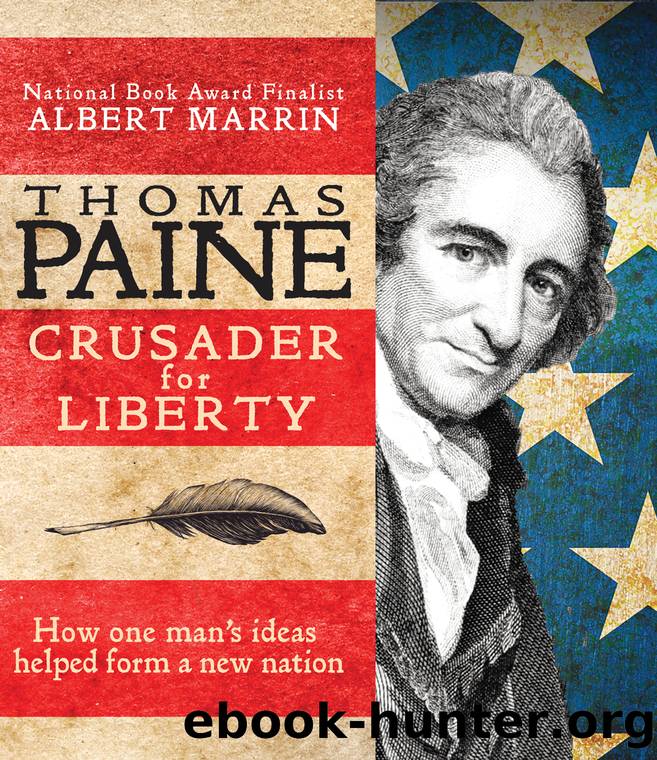Thomas Paine by Albert Marrin

Author:Albert Marrin [Marrin, Albert]
Language: eng
Format: epub
ISBN: 978-0-385-38605-0
Publisher: Random House Children's Books
Published: 2014-11-10T16:00:00+00:00
During the September Massacres (September 2 to 7, 1792), sansculottes stormed five Paris prisons and murdered thirteen hundred inmates, including 225 Catholic priests, with clubs, knives, and meat cleavers. The blood had scarcely dried in the streets when Paine reached the capital a week later. On September 20, French forces narrowly defeated the invaders, saving Paris and restoring a measure of calm.
A sansculotte killing a nobleman during the September Massacres. (c. 1792) Credit 3.13
The big question when Paine arrived was what to do about the king. Louis XVI had pretended to accept the Revolution while plotting against it. As the war began, he secretly wrote the Austrians, pressing them to invade his country and crush the Revolution. When a locksmith reported that His Majesty had a hidden safe, guards broke it open and found copies of his letters. The National Convention immediately abolished the monarchy, declared France a republic, and charged the former king with treason.
During the trial, Paine, the hater of monarchy, urged mercy. Speaking slowly to allow the translator to keep up, he voted Louis guilty of treason. Yet he continued, “As France has been the first of European nations to abolish royalty, let her also be the first to abolish the punishment of death.” Let France jail the disgraced king until the war ended, then send the royal family into exile in the United States. Executing Louis would just make the enemy fight harder, while angering the Americans, who were still grateful for his help in winning their independence.35
The National Convention approved the death penalty by a single vote. Like so much else in France, the method of execution had, until then, depended on the victim’s social class. Traditionally, nobles found guilty of a capital crime died “honorably,” beheaded swiftly with a sword or ax. Commoners died “dishonorably” by hanging, often slowly and painfully as the noose choked them. On January 21, 1793, the disgraced king died “democratically” by a novel method.
Named for its inventor, Dr. Joseph Guillotin, the guillotine was a beheading machine designed to execute people of all classes the same way. The device had two fourteen-foot posts and an eighty-eight-pound blade, razor sharp, set in grooves between them and raised by a pulley. The masked executioner tied the condemned to a board, secured the person’s neck in a wooden collar, and released the pulley. Down came the blade with a force of 888 pounds per square inch. “The head flies off, blood spurts, the man is no more,” Dr. Guillotin wrote proudly. The executioner then lifted the severed head by the hair and showed it to the spectators, to cheers of “Long live the Republic.” For the first time in European history, a king met his end like a commoner.36
Download
This site does not store any files on its server. We only index and link to content provided by other sites. Please contact the content providers to delete copyright contents if any and email us, we'll remove relevant links or contents immediately.
The Story of the Scrolls by The Story of the Scrolls; the M(725)
Harriet Tubman: The Biography by University Press(690)
Drawing by Maury Aaseng(615)
American Indian Stories by Zitkala-Sa(606)
When the World Was Ours by Liz Kessler(586)
Fallout by Steve Sheinkin(553)
Escape to Gold Mountain by David H.T. Wong & David H.T. Wong(544)
One Dead Spy (Nathan Hale's Hazardous Tales Book 1) by Nathan Hale(519)
The Great Depression (Inquire and Investigate) by Amidon Lusted Marcia(500)
Astrophysics for Young People in a Hurry by Neil DeGrasse Tyson(499)
Don't Know Much About History [30th Anniversary Edition] by Kenneth C. Davis(492)
The Age of Faith: The Story of Civilization by Will Durant(470)
Farewell to Manzanar by JEANNE HOUSTON(449)
Everything: Ancient Egypt by National Geographic Kids(447)
The Second World War by Paul Dowswell(432)
The Story Pirates Present: Digging Up Danger by StoryPirates & Jacqueline West(430)
Who Was Queen Victoria? by Jim Gigliotti(421)
Abraham Lincoln by George S. McGovern(420)
Traveling Man: The Journey of Ibn Battuta 1325-1354 by James Rumford(409)
